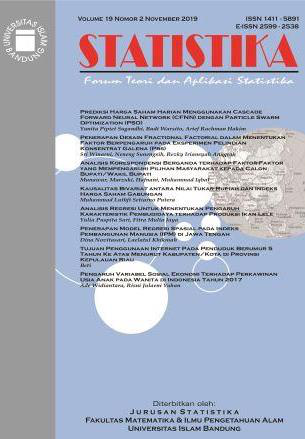Model Matriks Fuzzy untuk Masalah Kesehatan Mata Anak Sekolah Dasar Akibat Pembelajaran Daring di Masa Pandemi Covid-19
DOI:
https://doi.org/10.29313/statistika.v22i1.591Keywords:
Model Matriks Fuzzy, Matriks ATD, Matriks RTD, Matriks CETD, Computer Vision SyndromAbstract
ABSTRAK
Pembelajaran daring dimasa pandemi Covid-19 mengakibatkan meningkatnya intensitas penggunaan komputer atau gadget oleh siswa. Penggunaan komputer dalam waktu yang lama dapat menyebabkan kelelahan mata digital yang disebut dengan Computer Vision Syndrome (CVS). Penelitian ini bertujuan untuk menganalisis batas usia maksimum anak Sekolah Dasar mengalami gangguan kesehatan mata akibat pembelajaran daring dimasa pandemi covid-19. Kondisi kesehatan mata yang diamati dalam penelitian ini adalah gejala CVS yang dialami oleh siswa sebelum dan sesudah pandemi. Populasi dalam penelitian ini adalah siswa SD Islam Ibnu Sina Bandung tahun 2021 dengan jumlah sampel 180 orang. Metoda yang digunakan dalam penelitian ini adalah model matriks fuzzy. Model matriks fuzzy merupakan model sederhana yang mentransformasikan data mentah dari suatu permasalahan nyata ke dalam bentuk matriks fuzzy dengan menggunakan teknik rata-rata dan standar deviasi. Berdasarkan hasil analisis, diperoleh bahwa usia maksimum siswa memiliki gejala CVS berada pada kelompok usia 10 - 11 tahun. Kelompok lain yang juga memiliki gejala CVS yang harus mendapat perhatian adalah kelompok usia 12 – 13 tahun. Hal ini disebabkan karena durasi penggunaan gadget untuk pembelajaran daring pada anak usia 10 - 13 tahun lebih lama dibandingkan kelompok usia di bawahnya, yaitu antara 6 – 7 jam per hari. Disamping itu lebih dari 50% anak pada kelompok usia ini menggunakan smartphone untuk kegiatan daring.
ABSTRACT
Online learning during the pandemic of Covid-19 has resulted in increased use of computer or gadget by students. The frequent use of gadgets causes a digital eye strain called the Computer Vision Syndrome (CVS). This study is purposed to analyze the maximum age limit of Elementary School students who suffered eye health problems due to online learning during the Covid-19 pandemic. The population of this study is the students of Ibnu Sina Islamic Elementary School Bandung 2021, with 180 students in total. Method used in this study is a fuzzy matrix model. Fuzzy matrix model is a simple model used to transform raw data from real world problem into a fuzzy matrix by using average and standard deviation technique. The steps taken are: (1) to form a time dependent matrix from the raw data; (2) convert the time dependent matrix into ATD (Average Time Dependent) matrix; (3) calculate the mean and standard deviation; (4) forming a Fuzzy Matrix or RTD (Refined Time Dependent) matrix; (5) form the CETD (Combined Effective Time Dependent) matrix. The result of the analysis shows that the maximum age group of Elementary School students with CVS symptoms is 10-11 years old. Another group with CVC symptoms and needed attention is the age group of 12-13 years old. This is because the students in the age group of 10-13 years use gadgets more frequently than any other age groups below them, which is up to 6-7 hours per day. Furthermore, more than 50% of students in this age group use smartphones for online learning.
References
Bali, J., Neeraj, N., & Bali, R. (2014). Computer vision syndrome: A review. Journal of Clinical Ophthalmology and Research, 2(1), 61. https://doi.org/10.4103/2320-3897.122661
Deshmukh, R. (2021). Fuzzy Matrix Model for Analyzing Problems in Agriculture Sector. June, 901–905.
Jackson, S., Nivedha, S., Amutha, P., & Anny, T. (2018). An Analysis of Water Quality Using Fuzzy Matrices. April.
Kandasamy, Vasantha; Smarandache, Florentin; Illanthenral, K. (2007). Fuzzy Matrix Theory and Models for Social Scientists. 1–352.
Kokab, S. & Khan, M. I. (2012). Computer Vision Syndrome: Journal of Evolution of Medical and Dental Sciences, 1(6), 1223–1226.
Kuppuswami, G., Sujatha, R., & Vasantha Kandasamy, W. B. (2015). Study of traffic flow using CETD matrix. Indian Journal of Science and Technology, 8(24), 1–5. https://doi.org/10.17485/ijst/2015/v8i24/80191
Madhuri, V., & Amudhambigai, B. (21 C.E.). a Study on the Health Hazards of the Women Scavengers Using Fuzzy Matrix. Science Park, 3(28). http://scienceparks.in/ArticlePDF/217.pdf
Puspa, A. K., Loebis, R., Nuswantoro, D., Ilmu, D., Mata, K., Kesehatan, D., & Pencegahan, M.-K. (2018). Pengaruh Penggunaan Gadget terhadap Penurunan Kualitas Penglihatan Siswa Sekolah Dasar. Global Medical and Health Communication, 6(47), 28–33. https://doi.org/10.29313/gmhc.v6i1.2471
Radhika, D., Missier, S. P., & Son, J. (2017). Fuzzy Matrix Analysis in Aqua Culture. January 2018.
Randolph, S. A. (2017). Computer Vision Syndrome. Workplace Health and Safety, 65(7), 328. https://doi.org/10.1177/2165079917712727
Seguí, M. D. M., Cabrero-García, J., Crespo, A., Verdú, J., & Ronda, E. (2015). A reliable and valid questionnaire was developed to measure computer vision syndrome at the workplace. Journal of Clinical Epidemiology, 68(6), 662–673. https://doi.org/10.1016/j.jclinepi.2015.01.015
Sugiyono. (2011). Metodologi penelitian kuantitatif kualitatif dan R&D (Alpabeta (ed.)).
Suvitha, V. (2021). An analysis on Sustainability of Women in Entrepreneurship using Fuzzy Matrix Example : 25(4), 15320–15326.
Valcheva, K. P., Krivoshiiska-valcheva, E. K., & Stateva, D. V. (2016). Computer eye syndrome in children aged. Journal of IMAB, 22(1), 1075–1077.
















